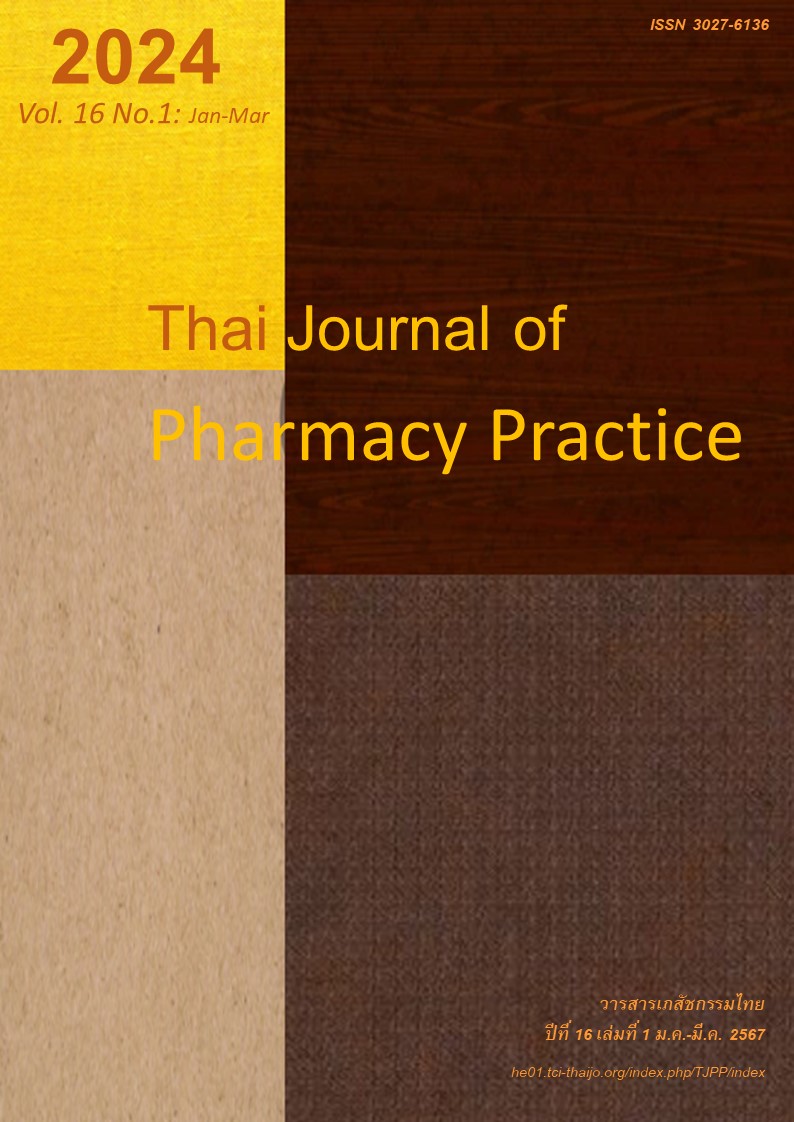การพัฒนาฐานข้อมูลยาคู่เหมือนในประเทศไทย
Main Article Content
บทคัดย่อ
วัตถุประสงค์: เพื่อพัฒนาฐานข้อมูลยาคู่เหมือนในประเทศไทยให้เป็นแหล่งสืบค้นในโรงพยาบาล วิธีการ: ผู้วิจัยพัฒนาฐานข้อมูลยาคู่เหมือนตามหลักการของวงจรการพัฒนาระบบ (System Development Life Cycle) ซึ่งประกอบด้วย 6 ขั้นตอน ได้แก่ การศึกษาขั้นต้น การวิเคราะห์ระบบ การออกแบบระบบ การเขียนและทดสอบโปรแกรม การทดสอบและการประเมินระบบ และการประเมินความพึงพอใจในการใช้งานฐานข้อมูลทำในเภสัชกรโรงพยาบาล จำนวน 85 คนที่เลือกมาแบบสะดวกและแบบ สโนว์บอล ผลการวิจัย: ฐานข้อมูลยาคู่เหมือนในประเทศไทยที่พัฒนาขึ้นมีการกำหนดระดับนัยสำคัญทางคลินิกของยาคู่เหมือนเป็นระดับที่ 1-4 ตามความรุนแรง ฐานข้อมูลประกอบด้วยรายการยาคู่เหมือนในรูปแบบยาเม็ดและยาแคปซูล 193 คู่ ยาคู่เหมือนสามารถจัดประเภทได้ 3 ประเภท ได้แก่ ชื่อคล้าย/ออกเสียงคล้าย/เขียนคล้าย บรรจุภัณฑ์คล้าย และรูปร่างเม็ดยาคล้าย โดยยาคู่เหมือนประเภทชื่อคล้าย/ออกเสียงคล้าย/เขียนคล้าย พบว่ามีการรายงานมากที่สุด ผู้ทดลองใช้ฐานข้อมูลพึงพอใจอยู่ระดับมากในด้านการออกแบบและด้านการค้นหาและการแสดงผล และมีความพึงพอใจมากที่สุดในด้านการนำไปใช้ สรุป: ฐานข้อมูลยาคู่เหมือนในประเทศไทยที่พัฒนาขึ้นโดยคณะเภสัชศาสตร์ มหาวิทยาลัยอุบลราชธานี เป็นฐานข้อมูลแรกที่รวบรวมรายการยาคู่เหมือนอย่างเป็นระบบ สามารถค้นหายาคู่เหมือนได้จากชื่อสามัญทางยา ชื่อการค้า ระดับนัยสำคัญทางคลินิกของยาคู่เหมือน และระดับความรุนแรงของความคลาดเคลื่อนทางยา ฐานข้อมูลนี้สามารถใช้เป็นแหล่งอ้างอิงและสืบค้น ตลอดจนเป็นเครื่องมือในการเฝ้าระวังและป้องกันปัญหายาคู่เหมือนได้ทั้งในโรงพยาบาลและระดับประเทศ
Article Details

อนุญาตภายใต้เงื่อนไข Creative Commons Attribution-NonCommercial-NoDerivatives 4.0 International License.
ผลการวิจัยและความคิดเห็นที่ปรากฏในบทความถือเป็นความคิดเห็นและอยู่ในความรับผิดชอบของผู้นิพนธ์ มิใช่ความเห็นหรือความรับผิดชอบของกองบรรณาธิการ หรือคณะเภสัชศาสตร์ มหาวิทยาลัยสงขลานครินทร์ ทั้งนี้ไม่รวมความผิดพลาดอันเกิดจากการพิมพ์ บทความที่ได้รับการเผยแพร่โดยวารสารเภสัชกรรมไทยถือเป็นสิทธิ์ของวารสารฯ
เอกสารอ้างอิง
Ciccarello C, Leber MB, Leonard MC, Nesbit T, Petrovskis MG, Pherson E, et al. ASHP guidelines on the pharmacy and therapeutics committee and the formulary system. Am J Health Syst Pharm 2021; 78: 907-18.
Association of Hospital Pharmacist (Thailand). Framework of hospital drug system [online]. 2020 [cited Aug 6, 2022]. Available from: www.thaihp.org /?fbclid=IwAR1itl_pQ0hVUnrJEyNBzfI_OBKIvUbos2QeTzhVQBtG1KDFGnaZxFtJN0U
Joint Commission on Accreditation of Healthcare Organizations (JCAHO). JCAHO update for infection control: 2005 patient safety goals warn of sound-alike drugs [online]. 2005 [cited Oct 11, 2022]. Available from: www.reliasmedia.com/articles/3258-jcaho-update-for-infection-control-2005-patient-safety-goals-warn-of-sound-alike-drugs
World Health Organization. WHO launches 'Nine patient safety solutions' [online]. 2007 [cited Aug 12, 2022]. Available from: www.who.int/news/item/02-05-2007-who-launches-nine-patient-safety-solutions
Limpanyalert P. 2P Safety patient and personnel safety [online]. 2017 [cited Jan 2, 2022]. Available from: hacc.kku.ac.th/haccupload_news/pdftitle/Tue2 4545uFpjMOP.pdf
Emmerton LM, Rizk MF. Look-alike and sound-alike medicines: risks and 'solutions'. Int J Clin Pharm 2012; 34: 4-8.
Institute for Safe Medication Practices (ISMP). ISMP list of confused drug names [online]. 2019 [cited Oct 11, 2022]. Available from: www.ismp.org/recommen dations/confused-drug-names-list
Bryan R, Aronson JK, Williams AJ, Jordan S. A systematic literature review of LASA error interven- tions. Br J Clin Pharmacol 2021; 87: 336-51.
Chumchit C, Amrumpai Y, Treesak C. Recognition on medication safety and look-alike/sound-alike medication problems in Thai public hospitals. Science, Engineering and Health Studies 2015: 9: 40-51.
Chanakit T, Napaporn J, Chiempattanakajohn T, Sangkhawan S, Wichakot S. The survey of look alike /sound alike (LASA) drugs available in hospitals in Thailand. Afr J Pharm Pharmacol 2013; 7: 227-39.
de Vicente Mohino J, Bermejo Higuera J, Bermejo Higuera JR, Sicilia Montalvo JA. The application of a new secure software development life cycle (S-SDLC) with agile methodologies. Electronics 2019; 8: 1218.
Joseph AL, Stringer E, Borycki EM, Kushniruk AW. Evaluative frameworks and models for health information systems (HIS) and health information technologies (HIT). Stud Health Technol Inform 2022; 289: 280-5.
Phunaploy N, Chatwattana P. The concept of an intelligent database management system architec- ture on cloud to support the inventory storage. Journal of Industrial Education 2020; 19: 111-21.
Promsaka Na Sakolnakorn T, Sungkharat U, Tep- sing P. Problems and adjustments of convenience store entrepreneurs in three Southern border provinces in Thailand. NIDA Development Journal 2013; 53: 82-103.
National Coordinating Council for Medication Error Reporting and Prevention (NCC MERP). Types of medication errors [online]. 2022 [cited Oct 11, 2022]. Available from: www.nccmerp.org/types-medication-errors
Wongboonnak P. Look-alike sound-alike drugs situation in Thailand. HCU Journal of Health Science 2018; 22: 205-16.
Wongboonnak P. Resolving the problems on look-alike sound-alike drugs at the system level. Thai Journal of Pharmacy Practice 2017; 9: 251-8.
Faculty of Pharmaceutical Sciences URU. Drug iden tification database [online]. 2022 [cited Oct 11, 2022]. Available from: drugiden.ubu.ac.th/
Santell JP, Hicks RW, McMeekin J, Cousins DD. Medication errors: experience of the United States Pharmacopeia (USP) MEDMARX reporting system. J Clin Pharmacol 2003; 43: 760-7.
World Health Organization. Guidance on INN [on line]. 1997 [cited Dec 24, 2021]. Available from: www .who.int/medicines/services/inn/innquidance/en/


